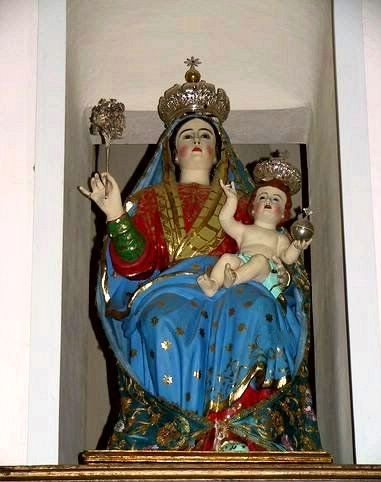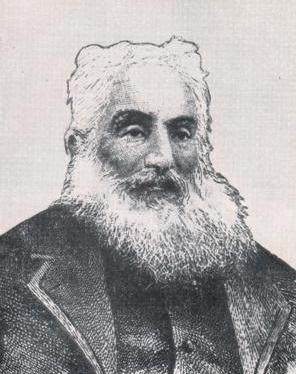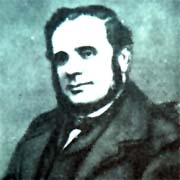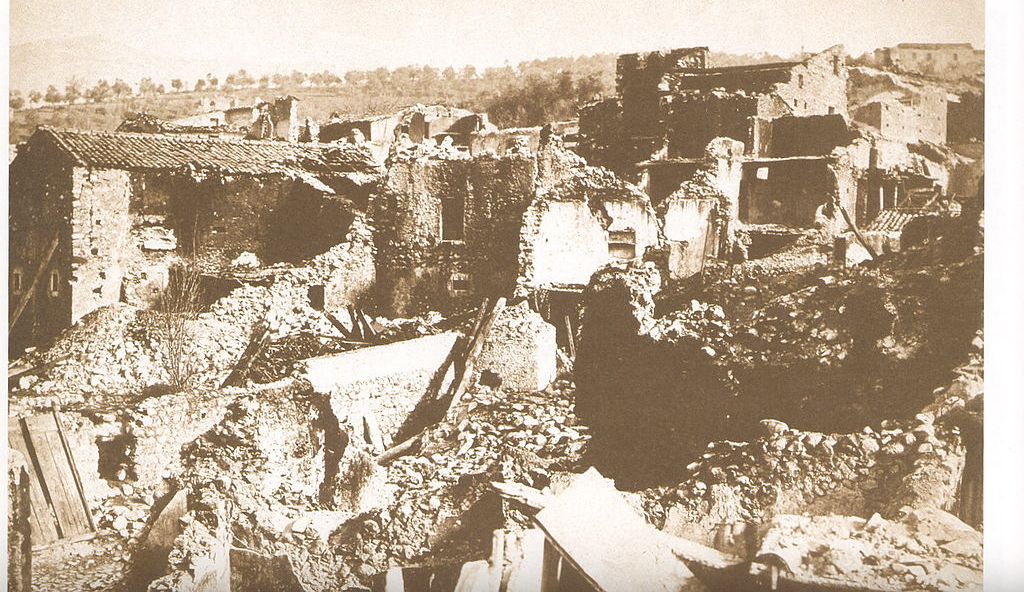
Assunta
By: Tom Frascella August 2015
Madonna Assunta Di Pierno

Picture of the Madonna Di Pierno Statue San Fele, Italy
August is the month in which San Felese all over the world celebrate the feast of the town’s patroness, Mary the Mother of Christ, in the form of the Madonna Di Pierno feast. I have written over the past several years a number of articles that have to do with the history of this celebration, its meaning to San Felese and to the people in the surrounding region. It is in fact a regional celebration, drawing Marian devotees from well beyond just the San Fele community. It is estimated that around 100,000 people make the annual pilgrimage to the tiny hamlet of Pierno which is part of commune San Fele.
The feast day of the Madonna Di Pierno is celebrated on the Sunday following the Roman Catholic Holy Day of the Assumption of Mary which falls annually on August 15th. Therefore, the Madonna Di Pierno feast is connected to the feast of the Assumption and forms part of what could be a week-long religious celebration in honor of Mary. The Madonna Di Pierno feast has been held continuously in San Fele since the year 1139 A.D. making it the longest continuous feast honoring Mary as Mother of Christ and Queen of Heaven in Roman Catholicism. In addition the original San Fele statue of the Madonna, as depicted above, is one of if not the oldest such Roman Catholic iconic Statues representing Mary with this status in existence.
This almost one thousand year old San Fele devotion to Mary manifests culturally in many ways, some of which I have previously written about. A common way that this devotion manifests is the fact that it is common for San Felese women, and women from the region, to have Mary or Maria as part of their names. In addition, some women are given the first name Assunta or in English, Assumption, in honor of Mary’s feast of the Assumption.
Many original San Felese organizations, both past and present, also show respect and connection to the cultural devotion in Mary by including Assunta in the organizations’ name. As an example, early New York Times articles from the 1890’s refer to the organization behind the Madonna feast and procession in Little Italy as the Congrega Assunta de Pierno. Before our own NJ society combined male and female membership there was a separate women’s organization which called itself “Societa Femminile Sanfelese Madonna Assunta di Pierno”. Even today in 2015 if you go to the Sydney, Australia suburb of Canada Bay/Burwood you will find reference to a group called “Associazzione Madonna Assunta Di Pierno” which is made up of San Felese/Lucanians who immigrated to Australia.
The bonds and cultural traditions are very strong between the San Felese and their Marian feasts. So great preparation, planning and effort goes into the week of the feasts. This brings us to an interesting fact in our website history regarding the week-long celebration and events as they occurred of 1860. The feast of the Assumption of Mary, August 15, 1860 fell on a Wednesday which means that the feast of the Madonna Di Pierno would have been celebrated the following Sunday, August 19, 1860.
In addition to the religious preparations for the feast, civil conditions as they existed were moving many Lucanians, that week toward bold and decisive action.
Assunta Dell Liberta’
Following the catastrophic earthquake of 1857 and its enormous destruction the Marian celebration of faith and hope, while more important than ever, took place in the most difficult of social and economic times for the region. The Bourbon regime responded to the plight of the people after the Great Potenza Earthquake of 1857 by sending in 5,000 troops to keep order and suppress civil strife. Little if any domestic aid was forthcoming from Naples, and the presence of National troops only served to create a siege mentality in the region. By 1860 about 2,500 frustrated and angry citizens of Lucania had engaged in enough acts of civil-disobedience to be declared “Briganti” brigands by the Neapolitan government. Declared outlaws in their own land they were forced to take refuge in the Apennine Mountains. However the region and its people which suffered together in those harsh times regarded many of the outlaws as folk heroes who struck a blow for liberty in their anti-government actions. So the brigands had the sympathy and secret support of the community as a whole.
While 2,500 men does not seem like a lot of rebels/insurgents it must be remembered that Lucania had a small general population of about 400,000. In terms of numbers of men formally being hunted by the Bourbons as rural outlaws throughout the Kingdom it is also a significant number. It is about equal to the number of most of the Kingdom of the Two Sicilies, other States combined. Again, Lucania’s response was a result of the extreme conditions in the aftermath of the great earthquake.
These 2,500 Lucanian brigands alluded captured and survived by being scattered throughout the mountains of Basilicata in small independent groups. For the most part, they avoided direct confrontation with Bourbon soldiers who were better armed and organized. When they attacked Bourbon controlled resources it tended to be out of desperation, a need for food, supplies or funds. The fact that they often attacked small unguarded convoys allowed them to be characterized as either bandits or modern “Robin Hoods” depending on perspective.
Before August 1860 whether these gangs should be called a part of a political movement, revolt or revolution I can’t say. Certainly many among them were outcasts for actions relating to political protest. But their small numbers and lack of cohesive political goal probably suggest that they were not a singular political opposition movement. They were however by far the most active native insurgents force in the Kingdom of the Two Sicilies, especially on the mainland prior to Garibaldi’s arrival.
Interestingly, Piedmont while aware of this on-going insurgency in Lucania and was seeking southern allies seems to have approached a Lucanian alliance very differently than its recruitment of other anti-Bourbon factions within the Kingdom of the Two Sicilies. This might be because the conflict between the Lucanians and the Bourbons was already in its third year following the devastation of the earthquake of 1857. Many of the Lucanian insurgents were not guided by abstract ideals of unity or freedom but rather survival. Their desperate conditions made them more radicalized and violent. Their body of men crossed class distinctions and presented more of a mob like aspect. Whatever the reason the Piedmont regime and Garibaldi seems to have approached alliance with Lucania in a sense, more straight forwardly. They would appeal directly to those actively engaged in resistance and revolt presenting that the common enemy were the Bourbons and collective action was the only method to right previous wrongs.
The young Italia insurgents within the region were a link but only a part of the insurgent force. As far as my research has taken me, Piedmont and Garibaldi seemed to have rested their efforts to draw Lucanian support with primarily one agent named Nicolo Cataldo Mignogna. Nicola Mignogna was born in Taranto, Apulia in 1808. He arrived in Basilicata as an agent of the Piedmont-Sardinia regime/ Garibaldi campaign in July of 1860. Garibaldi’s plans for the invasion of the southern mainland at all times contemplated landing in Calabria along a shore closest to Sicily. So his greatest pre-invasion effort was in securing support among Calabrians, as that is where he would land. Toward that end he sent in over eighteen agents to contact locals and on August 8, 1860 he sent a small exploratory force of 200. That force tested both Bourbon troop resolve as well as Calabrian popular support for the invasion. Nicolo as a native southern Italian had no trouble in locating insurgent groups and sympathizers on his arrival in Basilicata.

Photograph of Nicolo Cataldo Mignogna (1808-1870)
In his teens Nicolo moved to Naples to study law and to set up his law practice. In his twenties by legal training and class he would have been attracted to the liberal personal rights advocacy of the Carbonari movement. Eventually it appears he became involved in support of the “Young Italia” movement founded by Mazzini in 1831. The Young italia movement generally combined the liberal social agenda of the Carbonari with a strong national unification movement. In the years approaching 1848 he became associated with a branch of the “young Italia” movement prevalent in southern Italy known as “Figlioli della Giovane Italia”. This group was founded by Neapolitan born Professor Luigi Settembrini whose family originally was from Nova Seri in Matera, Basilicata.

Photograph of Luigi Settembrini (1813-1877)
As has been previously discussed the 1848 Mazzini inspired Young Italia/Carbonari revolt went very badly in the Kingdom of the Two Sicilies. Its failure the result of the Bourbon regime being supported by the Austrians army and British intelligence on the insurrectionist. Like most of the known “young Italia” Neapolitan leadership Mignogna was arrested in 1849 along with Settembrini during the Bourbon political suppression that followed the failed coup. Mignogna was released a few months after his arrest for lack of evidence but Settembrini was sentenced to death. Settembrini sentence was later reduced to life imprisonment. For the better part of the remaining 1850’s Settembrini languished in one of the many Bourbon island prisons off the coast of Naples. For about seven years Settembrini learned firsthand what rural Lucanians meant when the said “fa Nabalah” go to Naples.. He was eventually released and exiled To Malta in the late 1850’s.
Mignogna after his release from Neapolitan prison in 1851 continued to conspire to overthrow the Bourbons and was the recognized leader in another failed Neapolitan coup attempt in 1854-1855. He was arrested again in 1855 imprisoned, and tortured in prison to reveal the names of his coconspirators. Even under torture he refused to give up the identity of his fellow revolutionaries. After a highly publicized trial which got the attention of the international press he was found guilty and sentenced to exile in 1856.
In exile Mignogna travelled to Genoa. By 1857 a number of “young Italia” sympathizers had found support for the cause of unification in the government of Victor Emmanauel II. Once entrenched in the revolutionary forces in Genoa, where many in exile resided, he began to work with Mazzini. Mazzini remained convinced that the people of Italy were ready to rise up. Toward that goal he devised a bold plan to land armed rebels in Compania and start a people’s revolt against the Bourbons. This was actually Mazzini’s second attempt to do this as the first failed miserably in the late 1840’s when the landing was disclosed to the Bourbons by British intelligence which was intercepting Mazzini’s mail in London.
Mazzini chose Carlo Pisacane to lead the landing. Most of the 1,000 men proposed for the landing were Bourbon political prisoners housed in one of the isolated island prisons of the Neapolitan regime. The prisons were secured to prevent escape but not external attack. Mignogna was assigned to provide logistical planning based on his firsthand knowledge of Bourbon prisons. Mignogna however did not accompany the mission of what would become Carlo Pisacane’s failed invasion of Compania in 1857.
MIgnogna continued to work with the revolutionaries centered in Piedmont and helped Garibaldi with logistics as he planned for his voyage of “One Thousand” and the invasion of Sicily. He joined Garibaldi in Sicily and then was eventually smuggled onto the mainland as a Piedmont agent for the purpose of gathering support in Basilicata.
By early August we therefore see Nicolo Magnogna a southern leader of the Young Italia movement travelling about in Basilicata trying to assemble support for the cause of unification among the Basilicatan/Lucanians insurgents and young Italia sympathizers. He was a very good choice for this mission and I am sure that his selection as the Piedmont agent was done with a great deal of thought. Within Lucania he would have been known as a close, longtime associate of both Mazzini, and Garibaldi. He would also have been known as a longtime associate of Settembrini and a leader among the Kingdom of the Two Sicilies “Young Italia” revolutionaries. But maybe more importantly he would have been known as a man who had risked his life for the cause of unification, been arrested several times, tortured and had not given up his fellow revolutionaries. He would have been viewed with great respect.
That command of respect paid off in central Lucania as the region planned for the Marian oriented feasts. As Lucania came together to prepare and celebrate the traditional religious feast of the Assumption of Mary on August 15th a very different unique gathering was also secretly occurring. From August 13th thru August 16th the small scattered insurgent groups combined with “Young Italia” supporters began gathering in and around the Basilicatan town of Corletto Perticara about twenty miles south of Potenza.
Later filed dispatches and British newspaper reports indicate that by the 16th of August the day after the feast of the Assumption about 2,000 Lucanian insurgents had gathered with Mignogna in Corletto. As far as I know this is the first time in the post-quake three year struggle that Lucanian forces had massed in such large numbers. Mignogna was determined by consensus to be their leader and a plan of action was drawn up. Under Mignogna’s direction the gathering and its goals presented formalized. Apparently first a Proclamation was announced by the provisional command of the Lucanian insurgents announcing the motives and goals of the insurrection. Second, another proclamation issued encouraging defection from the Bourbon army. Third, an order of the day to the armed insurgent force present and all Lucanian patriots was issued directing a march on the Basilicatan capitol of Potenza.
As I previously noted in earlier articles the great Neapolitan earthquake of 1857 should have been called the great Potenza earthquake, as Potenza was the city closest to the epicenter of the quake. Potenza, the only “city” in Basilicata may have been home to between 40,000-60,000 people before the quake. Potenza suffered extensive damage during the quake with thousands killed or injured and 80% of all of its structures either collapsed or rendered uninhabitable. Three years after the quake it is difficult to know how many people were still living there among the ruins and devastation. It was not what most of us would think of as a Capitol but rather looked like it had been hit by an atomic bomb. Nevertheless as Lucania’s only “city” and the Capitol it had both strategic and symbolic value as the target of the insurrection.

Photograph of Potenza as it looked after the 1857 earthquake.
Mignogna and the insurgent force of 2,000 Lucanians entered into the Lucanian capitol on the morning of August 17, 1860 under force of arms. There they encountered a lightly armed Bourbon provincial force of about 400 defenders. The Bourbon defenders while at first surprised by the insurgent force descending on the Capitol, rallied and attacked. In the skirmish that followed seven Bourbon soldiers were killed, more wounded and still more captured before the Bourbon defenders withdrew from the Capitol.
The Lucanians had suffered three dead but had captured their Capitol. The fact that they were vastly under-armed and unsupported by external military aid had not stopped them from independently taking aggressive military action. Later in the afternoon of the 17th upon securing the capitol a Provincial assembly was convened and a Provisional government was established. Nicolo Mignogna was elected by the assembly as Provisional Governor of Basilicata. The Provisional Basilicatan government then formally declared the authority and sovereignty of King of the Two Sicilies to be ended in Basilicata. The Provisional government then formally recognized the sovereignty of King Victor Emmanuel II over Basilicata and declared Basilicata annexed to Piedmont-Sardinia.
This was an extraordinary turn of events, and unique in the The Second War of Unification. First it is, as far as I am concerned, the only actual example of a “peoples” revolt in the entire southern campaign of unification. At the time the seizing of the City of Potenza was taking place, Garibaldi’s invasion force was still in Sicily and Garibaldi was on a ship travelling back from Sardinia to Sicily. It was not a “revolt” conditioned on Garibaldi’s presence in the theater of operation, or the supply of arms or munitions from foreign sources. All of the participants were native southern Italians.
In addition, the establishment of an independent Provisional Government was also unique. Further the provisional government had taken action by vote not fiat. While Garibaldi had also established a Provisional Government in Sicily he had declared himself as dictator in the name of Victor Emmanuel. He had refused, for political reasons previously discussed, to declare annexation of Sicily to Piedmont so that question technically remained an open question of territorial status.
Of course the events taking place in Basilicata did not go unnoticed in Naples, especially as newspaper dispatches were issuing out of Potenza to the world almost in real time. From a military point of view the Bourbons knew that the situation and uprising in Basilicata had to be dealt with quickly and effectively. Historically it was always understood that in Basilicata resided all of the east west mountain passes connecting the two coasts of the southern Kingdom. If the insurgents controlled the passes they effectively isolated the two coasts, with their populations, armed forces and resources. In essence control of Basilicata by this rogue Provisional government would have been recognized by the military command in Naples as dividing the Kingdom in two.
Naples responded on August 17th by ordering about 1,000 elite soldiers of the Sixth Regiment of the Line, stationed in Salerno to immediately march out and retake the capitol city of Potenza. This unit was a well-equipped, well-trained professional military unit. By the morning of August 18th the Bourbon force was camped in and around the town of Eboli on the western edge of the Apennine Mountains east of Salerno. Based upon the traditional tactics of the “Briganti” in Lucania the Neapolitan command had every reason to believe that the show of military force issuing from Salerno and heading toward Potenza would result in the insurgents fading away into the safety of the mountains.
However, the act of seizing by force the State capitol, declaring a provisional government, and declaring Bourbon Rule ended was anything but the acts of unorganized Briganti. In one moment on August 17, 1860, Lucanians had seized the moment and their freedom. They had declared their independence from centuries of Bourbon rule, and chosen a new path toward destiny and unification. Now the question was would they defend that independence. If they did it would have to be without Garibaldi or the Piedmont army being present or even on the mainland of the southern Kingdom.
On Sunday August 19, 1860, which happened to be the feast of the Madonna Di Pierno, Mignogna now at the front of a force that had swelled to 3,000 men left Potenza heading west. His intent to meet and confront the Bourbon force heading toward the Capitol coming the east. As he marched westward Mignogna force continued to swell to an estimated 4,000-6,000 Lucanian volunteers.
Also on the morning of the 19th several hundred miles to the south Garibaldi recently returned to Sicily prepared his invasion force to board two steamships. As far as is known, Garibaldi was unaware of the events unfolding in the mountains of Lucania.
© San Felese Society of New Jersey